Equipment
 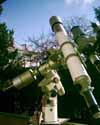 |
- Vixen GP 90M FH refractor (90/1000, f/11) - Bresser Champ FH refractor (80/400, f/5) - Vixen Great Polaris mount with RA and DE motor - Boxdörfer Elektronik Powerflex MTS-3SLP (alias Baader Sinus II) controller box - 1 x 12V, 2 x 15V power supply For more informations about Vixen telescopes try the Vixen homepage. For more informations about Bresser telescopes try the Bresser homepage. |
|
|
|
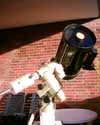 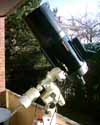 |
- Celestron C8 Schmidt-Cassegrain reflector (200/2000, f/10) - Telrad finder - Vixen Great Polaris mount with RA and DE motor - Boxdörfer Elektronik Powerflex MTS-3SLP (alias Baader Sinus II) controller box - 1 x 12V, 2 x 15V power supply For more informations about Celestron telescopes try the Celestron homepage. |
|
|
|
 |
The notebook is a Fujitsu iPC 366 with: - AMD K6-II, 366 MHz processor - 13,3'' TFT screen (1024 x 768) - 3 GB ATAPI hard disk - 24x CD-ROM drive - USB, RS232, PS2, parallel port - a very loud processor cooler :-( - Windows 98 SE and the QuickCam software - about 2 GB are free for images :-) Left to it you can see the adapted Logitech QuickCam Web. |
|
|
|
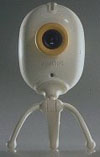 |
Since November 2001 I use the Philips ToUcam PCVC740K for photography of solar system objects and double stars. This webcam has a 1/4-inch CCD chip and a resolution of 640x480 pixel (single frame resolution 1280x960). It also have a good sensitivity of lower than 1 lux. If you also want to buy a webcam, then look for a model with CCD chip inside. Webcams with (cheaper) CMOS chips (like the Logitech QuickCam) are not useful because of their lower sensitivity, bad thermical behaviour and smaller resolution. |
|
|
|
 |
Here you can see the ToUcam mounted on the C8 telescope. For use with oculars my friend Gerd Wienekamp (the other half of Rainbow Serpent) built a special adapter. I use this adapter for both focal projection and ocular projection. Because of the small size of CCD chips you will get a very small field of view and, as a result, relatively small images (depending on the used webcam, resolution between 320x240 and 1280x960 pixel). First I record small videos of the celestial objects. Then I copy the files to a faster PC and process the pictures with image processing software like Paint Shop Pro (for individual images) or GIOTTO (for videos). |
|
|
|
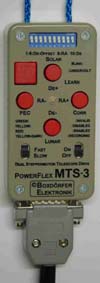 |
In September 2001 I swopped my Vixen controller box for the Powerflex MTS-3SLP from Boxdörfer Elektronik. With this controller box I have the possibility to connect my telescope with a computer. I have downloaded both, the Skymap Pro 7 demo program and the MTS-3SLP driver module mts_sinus.drv, written by Arno Pernozzoli. Now I have a very fantastic GOTO-function with an EASE OF USE! |
|
|
|
Here you can see some reflections within the tube of the Celestron C8. Such reflections reduce the contrast and you will loose details of bright objects (such as planets, moon or sun). Such reflections occur at light from the side. So one should use a dewcap to eliminate this. Maybe I will try to reduce these reflections by using antireflecting material. |
|
|
|
|
How does a bright star appear outside and within the focus of a Fraunhofer refractor? From left to right you can see the appearance of the star Altair (Alpha Aquilae) intrafocal, within focus and extrafocal.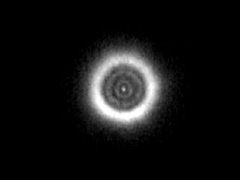 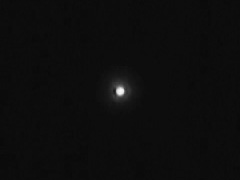 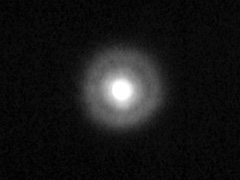 All these images were recorded with the Philips ToUcam PCVC740K mounted on the Vixen GP 90M using a 10mm Plössl ocular. |
|
|
|
|
| If you want to know more about the adaptation of web cams for astrophotography you must see the pages of AstroCam. You can download the famous software GIOTTO here. But, sorry, this site is in German! You can also use this software for video capturing. Find more information about Paint Shop Pro here. |
|